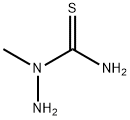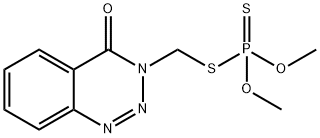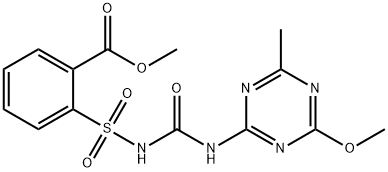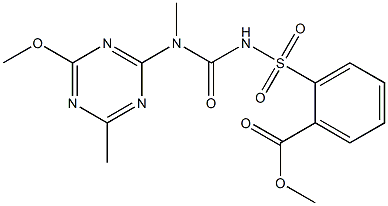2-Methyl-3-thiosemicarbazide
- CAS NO.:6938-68-7
- Empirical Formula: C2H7N3S
- Molecular Weight: 105.16
- MDL number: MFCD00010147
- EINECS: 230-071-5
- SAFETY DATA SHEET (SDS)
- Update Date: 2022-12-21 16:56:50

What is 2-Methyl-3-thiosemicarbazide?
What are the applications of Application
2-Methyl-3-thiosemicarbazide is This compound contains the rate constant for dihydroxy intermediate formation.
General Description
The rate constant for dihydroxy intermediate formation from 2-methyl-3-thiosemicarbazide was studied.
Properties of 2-Methyl-3-thiosemicarbazide
| Melting point: | 173-175 °C (lit.) |
| storage temp. | Keep in dark place,Inert atmosphere,Room temperature |
| CAS DataBase Reference | 6938-68-7(CAS DataBase Reference) |
Safety information for 2-Methyl-3-thiosemicarbazide
| Signal word | Warning |
| Pictogram(s) |
 Exclamation Mark Irritant GHS07 |
| GHS Hazard Statements |
H315:Skin corrosion/irritation H319:Serious eye damage/eye irritation H335:Specific target organ toxicity, single exposure;Respiratory tract irritation |
| Precautionary Statement Codes |
P261:Avoid breathing dust/fume/gas/mist/vapours/spray. P264:Wash hands thoroughly after handling. P264:Wash skin thouroughly after handling. P271:Use only outdoors or in a well-ventilated area. P280:Wear protective gloves/protective clothing/eye protection/face protection. P302+P352:IF ON SKIN: wash with plenty of soap and water. P305+P351+P338:IF IN EYES: Rinse cautiously with water for several minutes. Remove contact lenses, if present and easy to do. Continuerinsing. |
Computed Descriptors for 2-Methyl-3-thiosemicarbazide
New Products
4-AMINO-TETRAHYDRO-PYRAN-4-CARBOXYLIC ACID HCL 4-(Dimethylamino)tetrahydro-2H-pyran-4-carbonitrile 4-Aminotetrahydropyran-4-carbonitrile Hydrochloride (R)-3-Aminobutanenitrile Hydrochloride 3-((Dimethylamino)methyl)-5-methylhexan-2-one oxalate 1,4-Dioxa-8-azaspiro[4.5]decane 5-Bromo-2-nitropyridine Diclofenac Potassium Ornidazole IP Diclofenac Sodium IP/BP/EP/USP Mefenamic Acid IP/BP/EP/USP Aceclofenac IP/BP/EP Nimesulide BP SODIUM AAS SOLUTION ZINC AAS SOLUTION BUFFER SOLUTION PH 10.0(BORATE) GOOCH CRUCIBLE SINTERED AQUANIL 5 BERYLLIUM AAS SOLUTION AMOXICILLIN (AMOXYCILLIN) TRIHYDRATE Methylcobalamin (vitamin B12) SODIUM VALPROATE SODIUM METHYL PARABEN LAMOTRIGINERelated products of tetrahydrofuran






![(-)-2-[METHYLAMINO]-1-PHENYLPROPANE](https://img.chemicalbook.in/CAS/GIF/33817-09-3.gif)

You may like
-
 2-Methyl-3-thiosemicarbazide CAS 6938-68-7View Details
2-Methyl-3-thiosemicarbazide CAS 6938-68-7View Details
6938-68-7 -
 ethyl 2-(3-(tert-butyl)phenoxy)-2-methylpropanoate 98%View Details
ethyl 2-(3-(tert-butyl)phenoxy)-2-methylpropanoate 98%View Details -
 89796-99-6 Aceclofenac IP/BP/EP 98%View Details
89796-99-6 Aceclofenac IP/BP/EP 98%View Details
89796-99-6 -
 61-68-7 98%View Details
61-68-7 98%View Details
61-68-7 -
 Diclofenac Sodium IP/BP/EP/USP 98%View Details
Diclofenac Sodium IP/BP/EP/USP 98%View Details
15307-79-6 -
 Ornidazole IP 16773-42-5 98%View Details
Ornidazole IP 16773-42-5 98%View Details
16773-42-5 -
 51803-78-2 Nimesulide BP 98%View Details
51803-78-2 Nimesulide BP 98%View Details
51803-78-2 -
 15307-81-0 98%View Details
15307-81-0 98%View Details
15307-81-0
Statement: All products displayed on this website are only used for non medical purposes such as industrial applications or scientific research, and cannot be used for clinical diagnosis or treatment of humans or animals. They are not medicinal or edible.